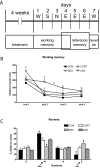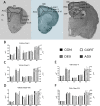Morphological correlates of corticosteroid-induced changes in prefrontal cortex-dependent behaviors
- PMID: 16120780
- PMCID: PMC6725252
- DOI: 10.1523/JNEUROSCI.1598-05.2005
Morphological correlates of corticosteroid-induced changes in prefrontal cortex-dependent behaviors
Abstract
Imbalances in the corticosteroid milieu have been implicated in several neuropsychiatric disorders, including depression and schizophrenia. Prefrontal cortex (PFC) dysfunction is also a hallmark of these conditions, causing impairments in executive functions such as behavioral flexibility and working memory. Recent studies have suggested that the PFC might be influenced by corticosteroids released during stress. To test this possibility, we assessed spatial working memory and behavioral flexibility in rats submitted to chronic adrenalectomy or treatment with corticosterone (25 mg/kg) or the synthetic glucocorticoid dexamethasone (300 microg/kg); the behavioral analysis was complemented by stereological evaluation of the PFC (prelimbic, infralimbic, and anterior cingulate regions), the adjacent retrosplenial and motor cortices, and the hippocampal formation. Dexamethasone treatment resulted in a pronounced impairment in working memory and behavioral flexibility, effects that correlated with neuronal loss and atrophy of layer II of the infralimbic, prelimbic, and cingulate cortices. Exposure to corticosterone produced milder impairments in behavioral flexibility, but not in working memory, and reduced the volume of layer II of all prefrontal areas. Interestingly, adrenalectomy-induced deleterious effects only became apparent on the reverse learning task and were not associated with structural alterations in the PFC. None of the experimental procedures influenced the morphology of retrosplenial or motor cortices, but stereological measurements confirmed previously observed effects of corticosteroids on hippocampal structure. Our results describe, for the first time, that imbalances in the corticosteroid environment can induce degeneration of specific layers of the PFC; these changes appear to be the morphological correlate of corticosteroid-induced impairment of PFC-dependent behavior(s).
Figures




References
-
- Ahima RS, Harlan RE (1990) Charting of type II glucocorticoid receptor-like immunoreactivity in the rat central nervous system. Neuroscience 39: 579-604. - PubMed
-
- Ahima R, Krozowski Z, Harlan R (1991) Type I corticosteroid receptor-like immunoreactivity in the rat CNS: distribution and regulation by corticosteroids. J Comp Neurol 313: 522-538. - PubMed
-
- Almeida OF, Conde GL, Crochemore C, Demeneix BA, Fischer D, Hassan AH, Meyer M, Holsboer F, Michaelidis TM (2000) Subtle shifts in the ratio between pro- and antiapoptotic molecules after activation of corticosteroid receptors decide neuronal fate. FASEB J 14: 779-790. - PubMed
-
- Altamura AC, Boin F, Maes M (1999) HPA axis and cytokines dysregulation in schizophrenia: potential implications for the antipsychotic treatment. Eur Neuropsychopharmacol 10: 1-4. - PubMed
Publication types
MeSH terms
Substances
LinkOut - more resources
Full Text Sources
Medical
Miscellaneous
